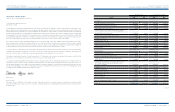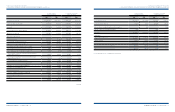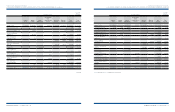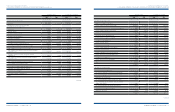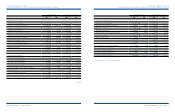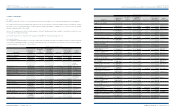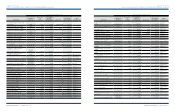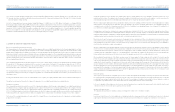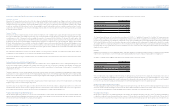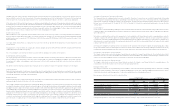Hyundai 2009 Annual Report Download - page 42
Download and view the complete annual report
Please find page 42 of the 2009 Hyundai annual report below. You can navigate through the pages in the report by either clicking on the pages listed below, or by using the keyword search tool below to find specific information within the annual report.
2009 2008 2009 2008
Net income attributable to equity holders of the parent ₩ 2,973,473 ₩ 857,751 $ 2,546,654 $ 734,627
Expected dividends on preferred stock (682,777) (335,799) (584,770) (287,597)
Net income available to common share 2,290,696 521,952 1,961,884 447,030
Weighted average number of common shares outstanding (*) 209,252,481 208,838,563 209,252,481 208,838,563
Basic earnings per common share ₩ 10,947 ₩ 2,499 $ 9.38 $ 2.14
HYUNDAI MOTOR COMPANY I 2010 ANNUAL REPORT I 83HYUNDAI MOTOR COMPANY I 2010 ANNUAL REPORT I 82
reasonably certain, at the inception of the lease, that the option will be exercised; (3) the lease term is for the major part of the economic life of the asset even if title is not
transferred; (4) at the inception of the lease, the present value of the minimum lease payments amounts to at least substantially all of the fair value of the leased asset; and
(5) the leased assets are of such a specialized nature that only the lessee can use them without major modifications; otherwise, it is classified as an operating lease.
At the commencement of the lease term, finance leases are recognized as assets and liabilities in their statements of financial position at amounts equal to the fair value of
the leased property or, if lower, the present value of the minimum lease payments, each determined at the inception of the lease. The discount rate to be used in calculating
the present value of the minimum lease payments is the interest rate implicit in the lease, if this is practicable to determine; if not, the lessee’s incremental borrowing rate
is used. Minimum lease payments are apportioned between the finance charge and the reduction of the outstanding liability. The finance charge is allocated to each period
during the lease term so as to produce a constant periodic rate of interest on the remaining balance of the liability.
Accrued Severance Benefits
Employees and directors of the Company and its domestic subsidiaries with more than one year of service are entitled to receive a lump-sum payment upon termination of
their service with each company, based on their length of service and rate of pay at the time of termination. The accrued severance benefits that would be payable assuming
all eligible employees were to resign amount to ₩3,178,864 million (US$2,722,563 thousand) and ₩3,067,643 million (US$2,627,306 thousand) as of December 31, 2009
and 2008, respectively.
In accordance with the National Pension Act, certain portions of accrued severance benefits are deposited with the National Pension Fund and deducted from accrued
severance benefits.
Actual payments of severance benefits by the Company and its domestic subsidiaries amounted to ₩602,326 million (US$515,867 thousand) and ₩787,393 million
(US$674,369 thousand) in 2009 and 2008, respectively.
Also, overseas subsidiaries’ accrued severance benefits are in accordance with each subsidiary’ policies and their counties’ regulations.
Accrued Warranties and Product Liabilities
The Company generally provides a warranty to the ultimate consumer for each product sold and accrues warranty expense at the time of sale based on actual claims history.
Also, the Company accrues potential expenses, which may occur due to product liability suit, voluntary recall campaign and other obligations as of the date of the end of
the reporting period. In addition, certain subsidiaries recognize other provision for the loss from the unused agreed credit limits, construction contracts, pre-contract sale or
service contract.
If the difference between nominal value and present value is material, the provision is valued at present value of the expenditures estimated to settle the obligation.
Share-based Payment
Equity-settled share-based payments to employees are measured at fair value of the equity instrument or the goods and services received and the fair value is expensed
on a straight-line basis over the vesting period. For cash-settled share-based payments, a liability equal to the portion of the goods or services received is recognized at the
current fair value determined at each end date of the reporting period.
Derivative Instruments
All derivative instruments are accounted for at fair value with the valuation gain or loss recorded as an asset or liability. If the derivative instrument is not part of a transaction
qualifying as a hedge, the adjustment to fair value is reflected in current operations.
The accounting for derivative transactions that are part of a qualified hedge based both on the purpose of the transaction and on meeting the specified criteria for hedge
accounting differs depending on whether the transaction is a fair value hedge or a cash flow hedge. Fair value hedge accounting is applied to a derivative instrument designated
as hedging the exposure to changes in the fair value of an asset or a liability or a firm commitment (hedged item) that is attributable to a particular risk. The gain or loss both
on the hedging derivative instruments and on the hedged item attributable to the hedged risk is reflected in current operations. Cash flow hedge accounting is applied to a
derivative instrument designated as hedging the exposure to variability in expected future cash flows of an asset or a liability or a forecast transaction that is attributable to
a particular risk. The effective portion of gain or loss on a derivative instrument designated as a cash flow hedge is recorded as accumulated other comprehensive income
(loss) and the ineffective portion is recorded in current operations. The effective portion of gain or loss recorded as accumulated other comprehensive income (loss) is
reclassified to current earnings in the same period during which the hedged forecasted transaction affects earnings. If the hedged transaction results in the acquisition of an
asset or the incurrence of a liability, the gain or loss in accumulated other comprehensive income (loss) is added to or deducted from the asset or the liability.
HYUNDAI MOTOR COMPANY
>>
NOTES TO CONSOLIDATED FINANCIAL STATEMENTS FOR THE YEARS ENDED DECEMBER 31, 2009 AND 2008
HYUNDAI MOTOR COMPANY
>>
NOTES TO CONSOLIDATED FINANCIAL STATEMENTS FOR THE YEARS ENDED DECEMBER 31, 2009 AND 2008
Accounting for Foreign Currency Transactions and Translation
The Company and its domestic subsidiaries maintain their accounts in Korean Won. Transactions in foreign currencies are recorded in Korean won based on the prevailing
rates of exchange on the transaction dates. Monetary accounts with balances denominated in foreign currencies are recorded and reported in the accompanying financial
statements at the exchange rates prevailing at the end dates of the reporting periods. The balances have been translated using the Base Rate announced by Seoul Money
Brokerage Services, Ltd., which was ₩1,167.60 and ₩1,257.50 to US$1.00 at December 31, 2009 and 2008, respectively, and translation gains or losses are reflected in
current operations.
Income Tax Expense
Income tax expense is determined by adding or deducting the total income tax and surtaxes to be paid for the current period and the changes in deferred income tax assets
or liabilities. In addition, current tax and deferred tax is charged or credited directly to equity if the tax relates to items that are credited or charged directly to equity in the
same or different period.
Deferred tax is recognized on differences between the carrying amounts of assets and liabilities in the financial statements and the corresponding tax bases used in the
computation of taxable profits. Deferred tax liabilities are generally recognized for all taxable temporary differences with some exceptions and deferred tax assets are
recognized to the extent that it is probable that taxable profit will be available against which the deductible temporary difference can be utilized. The carrying amount of
deferred tax assets is reviewed at each end date of the reporting period and reduced to the extent that it is no longer probable that sufficient taxable profits will be available
to allow all or part of the assets to be recovered.
Deferred tax assets and liabilities are classified as current or non-current based on the classification of the related assets or liabilities for financial reporting and according to
the expected reversal date of the specific temporary difference if they are not related to an asset or liability for financial reporting, including deferred tax assets related to carry
forwards. Deferred tax assets and liabilities in the same current or non-current classification are offset if these relate to income tax levied by the same tax jurisdictions.
Reclassification of the Subsidiaries’ Financial Statements
The Company reclassified some accounts in the subsidiaries’ financial statements according to the Company’s financial statements. This reclassification does not affect
the amount of net income or net assets in the subsidiaries’ financial statements. The assets and liabilities of the subsidiaries in financial industry are classified into specific
current or non-current assets and liabilities; however, if it is not possible, it is classified into other financial assets and liabilities.
Reclassification of Accounts in Prior Financial Statements
The Company reclassified some accounts in the prior financial statements according to the Company’s current financial statements for comparability purposes. This
reclassification does not affect the reported net income or net assets in the prior financial statements.
Earnings per Common Share
Basic earnings per common share are computed by dividing net income available to common shareholders by the weighted average number of common shares outstanding
during the period. Diluted earnings per common share are computed by dividing diluted net income, which is adjusted by adding back the after-tax amount of expenses
related to diluted securities, by weighted average number of common shares and diluted securities outstanding during the period.
Basic earnings per common share in 2009 and 2008 is computed as follows:
(*) Weighted average number of common shares outstanding includes transactions pertaining to change of treasury shares and exercise of stock option.
Korean Won in millions,
except per share amounts
U. S. Dollars (Note 2)
in thousands, except per share amounts


